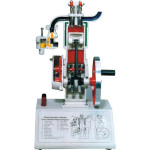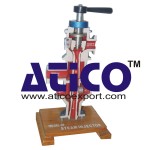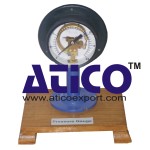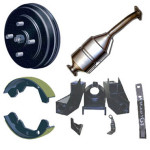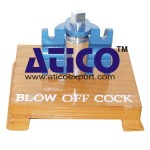Description
For classroom demonstrations and student investigations into the behaviour of fixed-wing aircraft and wing performance during take-off , flight and landing. The apparatus is an open-circuit wind tunnel with a model aircraft suspended in the working section. The model is supported by linkages that allow it to move vertically and to pitch about the quarter chord point independently. The working section is brightly illuminated and the aircraft model is clearly visible through a large transparent window. The operator flies the aircraft manually using a control column and throttle. These are positioned directly in front of the window and are arranged typically as found in a light aircraft, providing realistic simulation of flight and the effect of the control surfaces. To fly the aircraft, the operator pushes the throttle lever forward to increase the tunnel airspeed. When the airspeed reaches a certain level the aircraft may be made to ‘take-off ’ by drawing the control column slowly back. A digital display shows air velocity (pressure) in the working section, attitude, altitude or lift force on the aircraft. Air enters the working section through a fl ow straightener. The throttle controls the air speed in the tunnel by regulating an axial flow fan downstream of the working section. The change in air speed in the wind tunnel simulates the effect of increasing the change in air speed of a real aircraft due to a change in thrust from the propeller. The control column is linked to the ‘all-flying’ tail plane of the aircraft. Pushing the column forward or pulling it back changes the angle of the whole tail plane. A scale on the control column indicates the tail plane angle. The control column differs from that of a normal aircraft in that it has no lateral control of the aircraft: it has no rudder on the tail plane and may only move up or down. A locking control under the control column can lock the angle of the tail plane to any setting. Small tufts cover the port wing of the aircraft. These show the direction and quality of airflow over the wing surface, to show separation and stall. Using the optional Smoke Generator (available separately) enhances flow visualization. An adjustable weight allows the student to set the centre of gravity of the model to different positions from fore to aft of the quarter chord point. A scale below the weight indicates the position. This enables students to derive the trim curves and identify the neutral point. To fi nd the lift characteristic of the aerofoil, students link the aircraft to a load cell and vary the angle of attack.
Learning Outcomes
A variety of practical demonstrations, ‘hands-on’ flight simulations, and student investigations into the behaviour of fixed-wing aircraft and wing performance, including:
Practical investigation of longitudinal stability and control of the aircraft to demonstrate behaviour during take-off , level flight and landing.
Determination of the effect of speed on attitude for level flight and stall.
Measurement of the lift curve for the wing up to and beyond stall.
Students can adjust the centre of gravity of the model to alter its trim. They can then plot trim curves and determine the neutral point.
Specifications
ATICO is committed to a programme of continuous improvement; hence we reserve the right to alter the design and product specification without prior notice.
Nett dimensions:
2300 mm x 1000 mm x 1600 mm
Nett weight:
262 kg
Packed dimensions:
3.98 m3
Packed weight:
516 kg
Working section :
450 mm x 225 mm
Tunnel fan :
Axial flow type
Maximum air velocity:
21 m.s–1 (41 knots)
Air speed regulation:
Hand throttle connected to three-phase inverter
Model wing section:
NACA 2412
Model length:
440 mm
Model wing span:
220 mm
Model aircraft:
Fixed main wing, pivoted tailplane and two-blade
propeller
Aircraft effective weight:
5 Newtons
Accessories (included):
• Chart recorder lead
• Spare load cell cord
• Two sets of electrical cabinet keys
Operating Conditions
- Operating Environment:
Laboratory - Storage Temprature Range :
–25°C to +55°C (when packed for transport) - Operating Temprature range:
+5°C to +40°C - Operating relative humidity range:
80% at temperatures < 31°C decreasing linearly to 50% at 40°C



